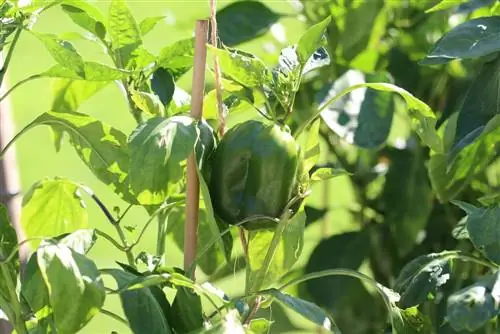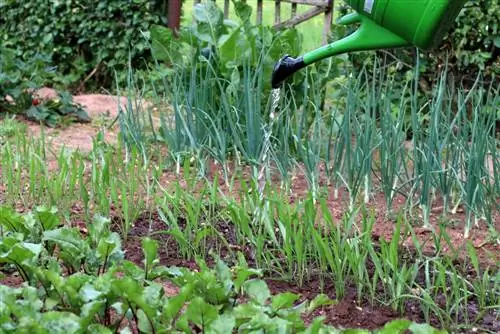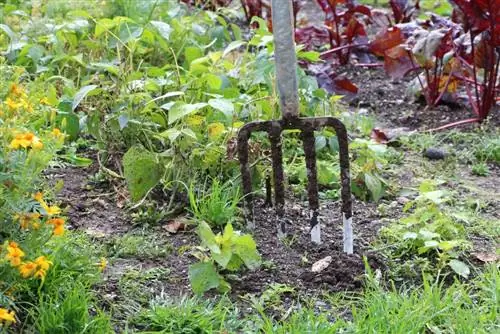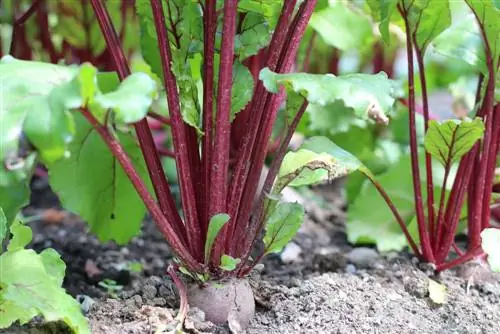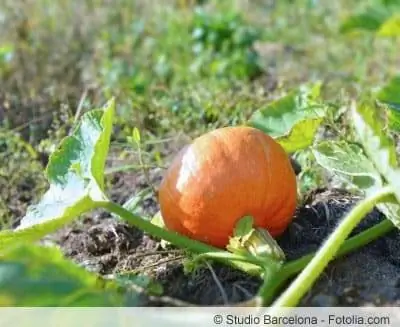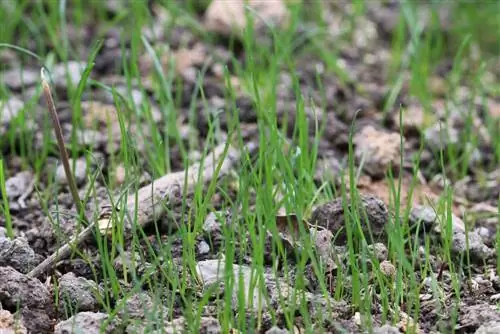- Author admin [email protected].
- Public 2023-12-17 03:39.
- Last modified 2025-01-24 12:45.
Planting times for vegetables depend on the type of vegetable. The timing of sowing and planting can have a positive or negative impact on the quality and vegetable yield. However, the water and nutrient requirements as well as light and temperature conditions of the varieties in question also play a decisive role. When choosing which varieties to grow, you should make sure that they are compatible with each other. Mixed crops and crop rotation can be beneficial for individual vegetables and counteract pest infestation.
Sowing and planting time March
Pre-culture
Basically, you shouldn't start pre-culture indoors before the first of March. Things are different in the cold frame or greenhouse; here the temperature and light conditions are much better, so sowing can start a little earlier. Some cold-sensitive vegetables can now be grown on the windowsill in pots or bowls or in the greenhouse.
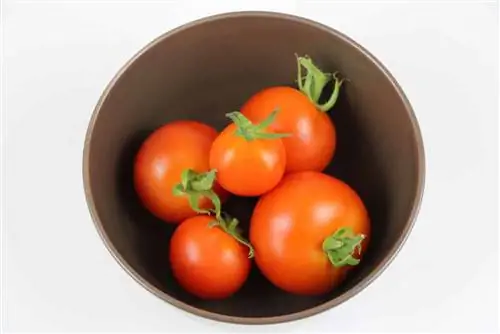
They include e.g. B. Tomatoes, peppers, broccoli, iceberg lettuce, celery, kohlrabi and leek. You should wait until around the middle of the month to sow tomatoes, otherwise the plants may become thin shoots due to a lack of light. Germination temperatures of around 20 degrees are required for pre-cultures and between 16 and 18 degrees after germination.
Tip:
Early potatoes can be planted now in March. They are placed in a bright place with temperatures between 10 and 12 degrees, where they form germs. They can then be planted in April.
Direct sowing
Only early vegetables that are insensitive to cold and can even tolerate temperatures below zero can be sown directly in March. Although early vegetable varieties are not as productive as summer varieties, they grow faster, so their cultivation time is shorter. They also cope better with the cooler temperatures.
These include spring and spring onions, spinach, legumes, some root vegetables, early varieties of carrots as well as pick and cut salads, although carrots, lettuce, spinach and onions can also be sown into April. Lettuce is the first vegetable of the year that can be sown. After sowing, lettuce should first be covered with fleece to create ideal conditions for the seedlings. To extend its harvest time, it can be re-sown several times at 14-day intervals.
Root vegetables that can be sown in March include turnips, radishes and radishes. Due to their low nutrient requirements, May turnips are ideal previous crops. Radishes should be sown as widely as possible and radishes are best sown under foil or in a cool cold frame. Legumes that are suitable for early sowing are peas or broad beans, although depending on the variety, peas can be sown several times at 14-day intervals until the beginning of June. Peas and beans should soak in a glass of water for about a day before sowing.
Tip:
Both old and new varieties are suitable for early sowing of lettuces, although a mixture of old and new resistant varieties is generally recommended.
Planting seedlings
- The seedlings of robust vegetable varieties can be planted from the end of March.
- They are planted in a cold frame or greenhouse.
- Red, white or cauliflower, savoy cabbage, broccoli and lettuces are suitable.
- In addition, onion sets can be planted in the ground; onion seeds have a very long growing time.
- Soak onion sets in water for a day before planting.
- This is how they grow better.
- It also prevents the onions from being pushed up, which would otherwise lead to crop losses.
Tip:
When growing cabbage, you should note that cabbage vegetables are heavy feeders, meaning that they remove a lot of nutrients from the soil.
Sowing and planting time April
growing young plants
Pre-germinated early potatoes can be planted in the second week of April. From the end of April you can sow lettuce, both head-forming and cut and picked lettuces, kohlrabi and celery to grow young plants in the garden. Only summer varieties should now be used for lettuce; early varieties would flower quickly and only produce very small heads.
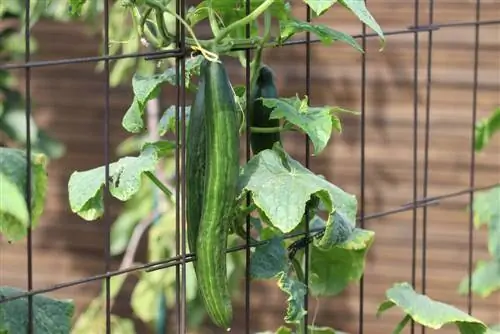
Cucumbers, pumpkins and eggplants can now be grown in pots in the greenhouse, as can bush and pole beans. The need for light is particularly high now. If necessary, the young plants may need to be transplanted into larger pots before being planted outdoors. They can finally go outside after the Ice Saints.
Direct sowing
Summer vegetables are sown in April, such as chard, broccoli, sweet corn, zucchini, sugar peas and leeks. Leeks are preferably sown in furrows approx. 10 cm deep so that they can form long white stems. From around the second week of April, the seeds of beetroot, radishes, Brussels sprouts, radishes, cauliflower, storage carrots and, if the soil temperature is around 7 degrees, also beetroot can be planted in the ground. For a higher yield from beetroot, it is advisable to sow them under foil. If radish is sown before April, it has a strong tendency to form shoots. Initially, it is recommended to cover the seedbeds with a close-meshed and air-permeable fleece, this creates a favorable microclimate.
Tip:
Seedlings of red, white and cauliflower, early kohlrabi varieties, fennel, onions and lettuce can be planted directly in the garden at the end of April.
Sowing and planting time May
Direct sowing
In May, subsequent sowing of various vegetables can be done directly outdoors, e.g. B. from lettuce, radishes, leeks or spinach. Kohlrabi and other types of cabbage can also be sown now and the beans will arrive from the middle of the month.
Planting seedlings
From mid-May, frost-sensitive vegetables can be planted directly outdoors, provided night frosts are no longer expected. This includes all summer salads, cucumbers, peppers, tomatoes, leeks, beetroot, Brussels sprouts, sweet corn, broccoli, radishes, fennel and early beans. Even though cucumbers and peppers can now be grown outdoors, cultivating these vegetables under foil or glass is more recommended, with the exception of outdoor cucumbers.
Mixed culture and crop rotation
Mixed crops in the vegetable garden are always preferable to monocultures. However, there are a few things to consider. It is important that the direct neighboring plants complement each other and do not harm each other. The root exudates or scents of some vegetables can be beneficial and protective for some neighboring plants and deadly for others. For example, you should not plant cruciferous vegetables in the immediate vicinity because they are incompatible with themselves and attract the same pests. The same vegetable plants that are grown in the same location for years remove important nutrients from the soil and literally leach it out over the years. This allows fungi, pests and pathogens to spread. Accordingly, a 3-year crop rotation is particularly recommended.

This looks like this: in the first year you grow heavy feeders such as potatoes, pumpkin, cabbage or cucumbers, in the second year only medium feeders such as lettuce, carrots, chard or fennel and in the third year follow weak feeders such as. E.g. onions, radishes or beans. In the fourth year, green manure should then be sown on the area in question. The following year you start again with the heavy eaters and repeat the whole thing.
Conclusion
Vegetables should not be missing from any garden, because there is nothing better than vegetables from your own garden. You can start sowing in pre-culture and sometimes directly from February/March, or you can buy pre-grown plants from a gardening store that you can then plant under glass or directly in the garden. However, for optimal harvest success, the sowing times of the various types of vegetables must be taken into account and adhered to, as must the crop rotation. In addition, attention must be paid to good and bad neighboring plantings. If you take all of this into account, nothing stands in the way of having your own fresh, crisp vegetables.
Planting times for vegetables
January
In January you can sow the first vegetables in the cold frame. Spinach, lamb's lettuce, chard and winter purslane are very suitable for this. Parsley, which goes well with almost all vegetables, can also be sown. If you have a heated greenhouse, you should sow lettuce, sugarloaf, kohlrabi, radishes, radishes and lots of garden cress.
February
February is the best month to sow endive, cauliflower, kohlrabi, peppers, tomatoes and onions in the greenhouse. But you can also sow seeds outdoors, e.g. B. Garden cress, spinach and broad beans. Lettuce, kohlrabi and radish can be planted under glass.
(March, April and May see above)
June
It can still be sown, e.g. chard, beetroot, carrots, radishes, fennel, garden cress, beans and raddichio. Now is the best planting time for celeriac, kohlrabi, cabbage, zucchini, cucumbers, tomatoes, pumpkin, eggplant, lettuce, pumpkin and winter leeks.
July
July is the last month to sow broccoli. Now plant winter cabbage, endive, savoy cabbage and spinach. Chinese cabbage and beans are sown.
August
Now the vegetables from the cold frame are planted in the garden beds. Because of the extended harvest season, field and winter lettuce are being sown now. Radishes, radishes, garlic and spinach can also be sown.
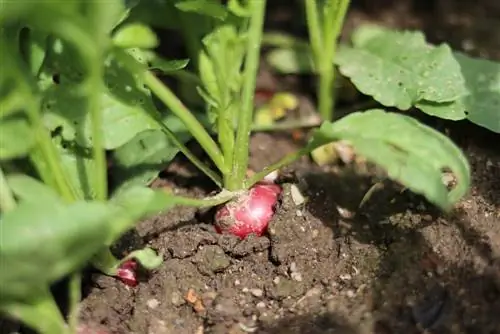
September
You can still sow under glass in September, e.g. lettuce and lamb's lettuce, spring onions, garden cress, endives, radishes and garlic. Spinach, radishes and winter onions are also added outdoors.
October
Lamb lettuce and spinach can be sown outdoors in October. Otherwise only sow under glass, e.g. carrots, radishes, radishes and endives. At the beginning of the month, pointed cabbage, savoy cabbage, lettuce, winter onions, radishes, carrots, radishes, lettuce and rhubarb are planted.
November/December
There is no sowing or planting during these two months. The garden is largely dormant.

